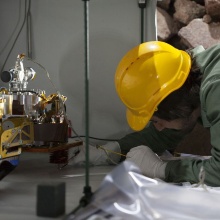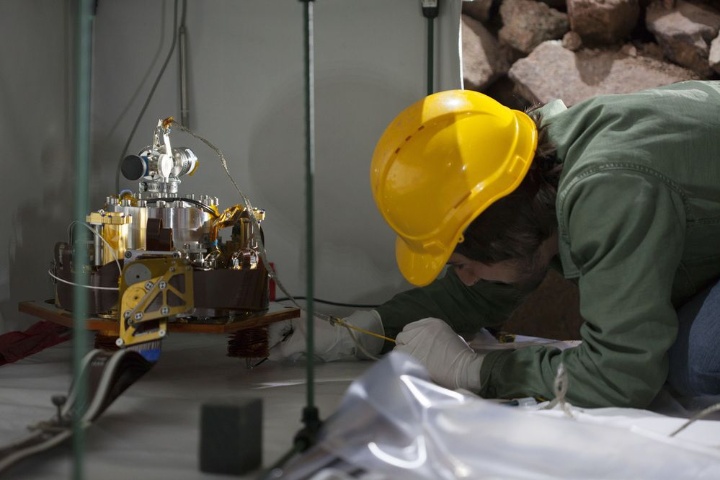Investigating the geophysical characteristics of the “red planet“ is the aim of the Mars mission InSight planned for 2018 by NSA and European partners. Furthermore, fundamental questions of the planet and sun system is to be clarified in order to gain a better understanding of the genesis of the planets of the inner solar system to which the earth also belong. A highly sensitive seismograph (SEIS) will be on board of the mission as a main instrument. At present the qualifying model, the “sister device” of this seismometer, is being tested at the Geoscientific Joint Observatory of KIT and the University Stuttgart (Black Forest Observatory – BFO).
Just like there are earthquakes on earth and tremors were also proven on the Moon, it is expected that there are likewise tremors on our neighbouring planets Mars, the size of which is between the Moon and Earth. SEIS is to observe these mars tremors and with that is a central instrument of the mission InSight (Interior Exploration using Seismic Investigations, Geodesy and Heat Transport.) On the basis of the recordings attempts are to be made to make statements on the structure of Mars, such as the size and characteristics of the core as well as the thickness of the crust.
Findings about the inner core of Mars
”Our knowledge about the structure of the body of earth is largely based on seismological measurements“, explained Rudolf Widmer-Schnidrig from the University of Stuttgart, one of the scientists at the BFO, “earthquake waves spread throughout the entire body of earth. In keeping with x-ray tomography in medicine, a tomographic illustration of the inner core of the earth can be derived.“ For that reason there is great hope that SEIS will provide many new findings about the inner core of Mars. There will be six seismometers in the instrument package SEIS, with which the ground motion can be recorded in the vertical and in two horizontal directions. “We erect the seismometers on the ground in meticulous handwork, adjust them and shield them from disturbances. The landing robot has to manage this independently on Mars. This alone requires a technical masterstroke“, said Thomas Forbriger from KIT. The scientists are testing at BFO how the various components originating from France, Germany, Great Britain, Switzerland and the USA interact.
Excellent measurement conditions
Excellent measurement conditions prevail at BFO. The microseisms in the disused ore mine near Schiltach in the Black Forest are particularly small, the seismometers operated provide data are some of the most low-noise ones on a global comparison??. In addition the BFO has a very good measurement infrastructure and is one of the very few seismological observatories where scientists work on site. This allows support to be provided at any time during instrument tests. The mine system is completely in granite. The inner part of the mine, that contains the measurement chambers for the instruments, is shielded from the outside world by two Druckschleusen. This part of the mine lies around 150 metre below the earth’s surface. The shielding of the instruments achieved through this from the impact of direct air pressure and temperature fluctuations as well as a distance of over 5 kilometres to zivilisatorischen Störquellen (industry, traffic) make the BFO an exceptionally quiet measurement location.
Expert Contact:
Rudolf Widmer-Schnidrig, Black Forest Observatory (BFO) of the University of Stuttgart and the Karlsruhe Institute of Technology (KIT),Tel. 07836 2151, E-Mail



